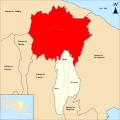|
Bangli Regency
 Bangli Regency is the one and only landlocked regency (kabupaten) of Bali, Indonesia. Up until 1907, Bangli was one of the nine kingdoms of Bali.[2] The capital has a famous Hindu temple, the Pura Kehen, which dates from the 11th century. Bangli also has one village which surrounds a hill, Demulih. Pura Dalem Galiran is 1.4 km north-west of Bangli.[3] Pura Dalem Penunggekan, 1.3 km south of the town center,[4] shows on its outside walls sculpted reliefs of sinners in hell. GeographyGeneralitiesBangli is the only regency in Bali which is landlocked. Its northern part includes the crater in which Gunung Batur sits, and the main road from Ubud in the south to the north coast through Kintamani and around Gunung Batur's crater.[5][6] It covers an area of 520.81 km2.[7] From the Demulih hill some 3 km west of Bangli,[8] much of southern part of the island can be seen: Kuta, Nusa Dua, Gianyar and a part of Klungkung. Administrative districtsThe Regency is divided into four districts (kecamatan), listed below with their areas and their populations at the 2010 Census[7] and the 2020 Census,[9] together with the official estimates as at mid 2022.[1] The most northern district - Kintamani, which is the primary highland region for the cultivation of arabica coffee - occupies over 70% of the regency's area and has 43.5% of its population. The table also includes the locations of the district administrative centres, the number of administrative villages in each district (totaling 68 rural desa and 4 urban kelurahan - the latter all in Bangli District), and its postal codes.
List of districts and villages in Bangli Regency as follows:
ClimateBangli has a tropical monsoon climate (Af) with moderate rainfall from April to October and heavy rainfall from November to March.
DemographyIt had a population of 215,353 at the 2010 Census[7] and 258,721 at the 2020 Census;[9] the official estimate as at mid 2022 was 267,133 - comprising 134,500 males and 132,600 females.[1] Its regency seat is the town of Bangli. HistoryProtohistory
In Manikliyu (west side of Bangli Regency),[11] a burial site was excavated in 1997 and 1998 which revealed two large sarcophagi and a bronze kettle drum, representing a unique burial system thus far unknown in Indonesia. The largest sarcophagus (length 206 cm, width 70 cm) is well preserved; the other sarcophagus (length 172 cm, width 69 cm) is partly broken. The bronze kettle drum (height 120 cm, diameter of the tympanon 77 cm) is decorated with eight stars on the tympanon, and human masks on the body. It contained human bones in flexed position that belonged to a young man of Mongoloid type, between 20 and 35 years old; the broken part of his upper face shows that he was killed by the impact of a sharp tool. The burial site also contained carnelians, beads, bronze spirals and bronze finger protectors. Some remnants broken pottery and pottery shards were also found beside the burial site and near the containers.[12] The drum is very similar to the Pejeng type,[12] the latter referring to the Moon of Pejeng, largest single-cast bronze kettle drum known in the world, found in Pejeng (village east of Ubud, Gianyar Regency). A. Calo suggests that such kettle drums were associated with early rice cults - and cultivation - in Bali: most of them are found near sources of irrigation water (lakes, springs or weirs in rivers); their shape and decoration are reminded in modern representations of female deities associated with rice and irrigation water, the latter originating in a pre-Hindu culture and later integrated into the Hindu-Balinese panel of gods. Ritual ceremonies honouring these deities are still held to this day at places where irrigation water first enters fields (bedugul) and at crater lakes, the highest sources.[13]
At Taman Bali and Bunutin, two villages close to each other about 5 km south of Bangli,[14] five sarcophagi were known before 1973. Two more were signalled in 1973, one of which buried 3 m deep in a rice field with its lid lying nearly 1.5 m away and partly broken, and containing various bronze objects including a small shovel, a ring, arm and ankle-rings and a number of spirals different from any formerly found in sarcophagi in Bali. The other sarcophagus signalled in 1973 was found by the villagers in Bunutin in 1971, buried nearly 1.5 m deep; its lid is absent and no associated artefacts were found. One of the five sarcophagi known before 1973 is kept in Gedong Arca Museum in Bedulu; as of 1974, the others were still in their place of discovery.[15] References
External links
|
||||||||||||||||||||||||||||||||||||||||||||||||||||||||||||||||||||||||||||||||||||||||||||||||||||||||||||||||||||||||||||||||||||||||||||||||||||||||||||||||||||||||||||||||||||||||||||||||||||||||||||||||||||||||||||||||||||||||||||||||||








